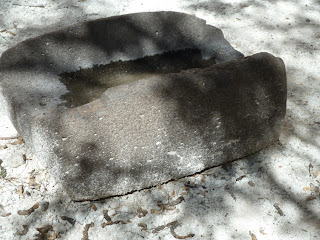Mesquite beans on the ground under the mesquite tree. In no time at all, you can collect enough for a meal. I did collect a bunch but made no attempt to eat them until I got home.
The collection site right behind our breakfast table. The picture was taken in January and all the beans were on the ground.
Back home, I tossed a bunch of the beans in a high power blender.
The ground up beans looked like this. I sifted them through a colander.
Animals on the other hand eat the whole thing, hull and bean, possibly doing some chewing and run it through their digestive tract and deposit the hulls on the ground.
The next step is to do something with the meal. You can get recipes online or you can just improvise. The mesquite meal is sweet with just a hint of sour. You can make a rue with it and add it to soup or parch it in a pan and use it as a thickener for stews as you would any flour. Unlike flower, it does have a distinctive taste, however which you may or may not like, mostly it is a little sour and sweet and you may need to experiment until you find where to put it into your food regimen.




















